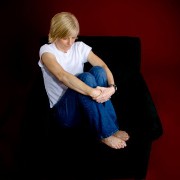 Photo: Getty Images
Photo: Getty Images
In the United States, about 5 million people have fibromyalgia, with 80 to 90 percent of patients being women, according to the U.S. Department of Health and Human Services Office on Women’s Health.
Patients with fibromyalgia have pains that occur all over their body — above and below the waist and on both sides of the body. The MayoClinic.com noted that the pain that fibromyalgia patients experience is described often as “a constant dull ache, typically arising from the muscles.”
In addition to the widespread pain, patients with fibromyalgia have additional pain at certain parts of the body when pressure is applied. These areas are called “tender points.”
There are 18 tender points, or nine pairs of tender points. These include:
• Inside of the knee
• Back of the neck behind the patient’s ear
• The midway point between the tip of the shoulder and the base of the neck
• Behind the bony part of the hip
• Above and toward the outside of the buttocks
• The area in which the back muscles meet the shoulder blade
• Above the collarbone
• Below and to the outside of the elbow crease
• Either right or left of the sternum
Finding the right treatment to manage the pain of fibromyalgia can be difficult and patients may need to try different treatments until they find the one that works best for them. Medications are one option. The U.S. Department of Health and Human Services Office on Women’s Health noted that several medications are approved by the U.S. Food and Drug Administration for fibromyalgia, including milnacipran, pregabalin and duloxetine.
The MayoClinic.com recommended that patients with fibromyalgia pain come up with a list of coping strategies when their pain becomes severe. Options include avoiding negative talk (instead of saying “I cannot do anything because of this pain,” say instead “I can do many things, but I just need to take breaks throughout the day"), telling other people about the symptoms, asking for help when it is needed, and using relaxation techniques.
Another option is cognitive behavioral therapy, a type of psychotherapy. In a study conducted in the UK with 442 people with chronic widespread pain, patients were in one of three groups:
1) 10 telephone cognitive behavioral therapy sessions with a therapist
2) exercise sessions with a fitness instructor
3) both interventions
Reuters Health reported that one-third of the participants in either of the cognitive behavioral therapy groups said they either felt “much better” or “very much better” at the end of the sessions.
References
UC San Diego Health Library. Fibromyalgia Tender Points. Web. 16 November 2011
http://myhealth.ucsd.edu/library/healthguide/en-us/support/topic.asp?hwid=aa103823
U.S Department of Health and Human Services Office on Women’s Health. Fibromyalgia Fact Sheet. Web. 16 November 2011
http://www.womenshealth.gov/publications/our-publications/fact-sheet/fibromyalgia.cfm
MayoClinic.com. Fibromyalgia: Symptoms. Web. 16 November 2011
http://www.mayoclinic.com/health/fibromyalgia/DS00079/DSECTION=symptoms
MayoClinic.com. Fibromyalgia Pain: Create a Plan for Coping. Web. 16 November 2011
http://www.mayoclinic.com/health/fibromyalgia-pain/AR00055/METHOD=print
Reuters Health. Talk Therapy by Phone May Ease Fibromyalgia: Study. Web. 16 November 2011
http://www.reuters.com/article/2011/11/14/us-talk-therapy-idUSTRE7AD2B220111114
Reviewed November 17, 2011
by Michele Blacksberg RN
Edited by Jody Smith





Add a Comment3 Comments
75% of people with fibromyalgia remain undiagnosed- the government and medicine dont care about people with fibromyalgia- they do very little research on fibromyalgia, doctors refuse to obtain education on painful conditions like fibromyalgia-and government wont do the right thing for people with fibromyalgia by requiring education on fibromyalgia or more research- fibromyalgia- like other painful conditions is a political issue that shows both medicine and governemtn are woefully out of touch with people suffering pain
November 19, 2011 - 11:06amThis Comment
i would bet if the number of men equalled the number of women with this disease we would have a cure by now. anonymous
March 15, 2012 - 5:45pmThis Comment
This is a wonderful article! Offering concise and complete information and I think that the idea of one-on-one CBT is wonderful. It would help reduce symptoms, especially on the bad days. I wish there were a network of people in this area that could support each other this way. It would also be great if there were some professionals in the group. Very good. Thank you.
November 17, 2011 - 7:31pmThis Comment